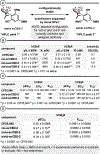Axially Chiral Cannabinoids: Design, Synthesis, and Cannabinoid Receptor Affinity
- PMID: 37314891
- PMCID: PMC11392426
- DOI: 10.1021/jacs.3c00129
Axially Chiral Cannabinoids: Design, Synthesis, and Cannabinoid Receptor Affinity
Abstract
The resorcinol-terpene phytocannabinoid template is a privileged scaffold for the development of diverse therapeutics targeting the endocannabinoid system. Axially chiral cannabinols (axCBNs) are unnatural cannabinols (CBNs) that bear an additional C10 substituent, which twists the cannabinol biaryl framework out of planarity creating an axis of chirality. This unique structural modification is hypothesized to enhance both the physical and biological properties of cannabinoid ligands, thus ushering in the next generation of endocannabinoid system chemical probes and cannabinoid-inspired leads for drug development. In this full report, we describe the philosophy guiding the design of axCBNs as well as several synthetic strategies for their construction. We also introduce a second class of axially chiral cannabinoids inspired by cannabidiol (CBD), termed axially chiral cannabidiols (axCBDs). Finally, we provide an analysis of axially chiral cannabinoid (axCannabinoid) atropisomerism, which spans two classes (class 1 and 3 atropisomers), and provide first evidence that axCannabinoids retain─and in some cases, strengthen─affinity and functional activity at cannabinoid receptors. Together, these findings present a promising new direction for the design of novel cannabinoid ligands for drug discovery and exploration of the complex endocannabinoid system.
Figures












References
Publication types
MeSH terms
Substances
Grants and funding
LinkOut - more resources
Full Text Sources

